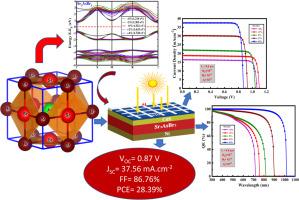Examining the electronic, structural, optical, and photovoltaic capabilities of Sr3AsBr3 perovskite under tensile and compressive strains with DFT and SCAPS-1D
IF 8.3
2区 材料科学
Q1 MATERIALS SCIENCE, MULTIDISCIPLINARY
引用次数: 0
Abstract
A significant amount of interest in the field of solar energy has recently been generated by the remarkable optical, structural, and electronic attributes of inorganic perovskite-based substances. A thorough investigation was conducted on how tensile along with compressive strains influence the electronic and optical properties of halide perovskite Sr3AsBr3, utilizing FP-DFT. The PBE functional is used to determine the direct bandgap of 1.512 eV for unstrained Sr3AsBr3 at the Γ position. The bandgap redshifts (1.216 eV at -4 % strain) under compressive strain and slightly increases (1.728 eV at +4 % strain) under tensile tension, causing the absorption coefficient to blueshift. The optical properties, including the functions of dielectric, electron energy loss function, and absorption coefficient, all indicate a considerable capacity for absorption in the area of the visible spectrum, and the band characteristics of this component agree with these qualities. We used Sr3AsBr3 absorbers and CdS electron transport layers (ETL) with different thicknesses, defect densities, and doping concentrations to study solar power capabilities using the SCAPS-1D simulator. The most effective arrangement (at -4 % strain) had a fill factor (FF) of 86.76 %, a short-circuit current density (JSC) of 37.5593 mAcm−2, an open-circuit voltage (VOC) of 0.8712 V, and a power conversion efficiency (PCE) of 28.39 %. Our findings support additional research into Sr3AsBr3, a promising perovskite for optoelectronic uses.

利用 DFT 和 SCAPS-1D 研究 Sr3AsBr3 包晶在拉伸和压缩应变下的电子、结构、光学和光伏性能
基于无机包晶的物质具有卓越的光学、结构和电子特性,最近在太阳能领域引起了广泛关注。我们利用 FP-DFT 对拉伸和压缩应变如何影响卤化物包晶 Sr3AsBr3 的电子和光学特性进行了深入研究。利用 PBE 函数确定了未应变 Sr3AsBr3 在 Γ 位置的直接带隙为 1.512 eV。在压缩应变作用下,带隙发生红移(应变为 -4 % 时为 1.216 eV),在拉伸作用下,带隙略有增加(应变为 +4 % 时为 1.728 eV),从而导致吸收系数发生蓝移。包括介电函数、电子能量损耗函数和吸收系数在内的光学特性都表明,在可见光谱区域具有相当大的吸收能力,而这种成分的波段特性也与这些特性相吻合。我们使用不同厚度、缺陷密度和掺杂浓度的 Sr3AsBr3 吸收体和 CdS 电子传输层(ETL),利用 SCAPS-1D 模拟器研究太阳能发电能力。最有效的排列(应变为 -4 %)的填充因子 (FF) 为 86.76 %,短路电流密度 (JSC) 为 37.5593 mAcm-2,开路电压 (VOC) 为 0.8712 V,功率转换效率 (PCE) 为 28.39 %。我们的研究结果支持对 Sr3AsBr3 这种有前途的光电用包晶石进行更多的研究。
本文章由计算机程序翻译,如有差异,请以英文原文为准。
求助全文
约1分钟内获得全文
求助全文
来源期刊

ACS Applied Materials & Interfaces
工程技术-材料科学:综合
CiteScore
16.00
自引率
6.30%
发文量
4978
审稿时长
1.8 months
期刊介绍:
ACS Applied Materials & Interfaces is a leading interdisciplinary journal that brings together chemists, engineers, physicists, and biologists to explore the development and utilization of newly-discovered materials and interfacial processes for specific applications. Our journal has experienced remarkable growth since its establishment in 2009, both in terms of the number of articles published and the impact of the research showcased. We are proud to foster a truly global community, with the majority of published articles originating from outside the United States, reflecting the rapid growth of applied research worldwide.
 求助内容:
求助内容: 应助结果提醒方式:
应助结果提醒方式:


